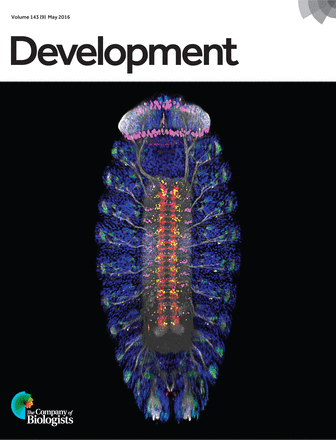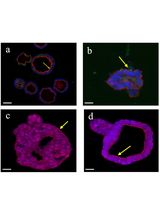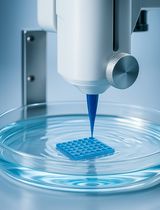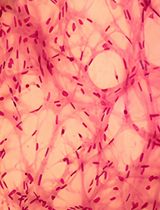- EN - English
- CN - 中文
Ex vivo Culture of Adult Mouse Antral Glands
成年鼠胃窦腺的离体培养
发布: 2017年01月05日第7卷第1期 DOI: 10.21769/BioProtoc.2088 浏览次数: 9312
评审: Rakesh BamHui ZhuAnonymous reviewer(s)
Abstract
The tri-dimensional culture, initially described by Sato et al. (2009) in order to isolate and characterize epithelial stem cells of the adult small intestine, has been subsequently adapted to many different organs. One of the first examples was the isolation and culture of antral stem cells by Barker et al. (2010), who efficiently generated organoids that recapitulate the mature pyloric epithelium in vitro. This ex vivo approach is suitable and promising to study gastric function in homeostasis as well as in disease. We have adapted Barker’s protocol to compare homeostatic and regenerating tissues and here, we meticulously describe, step by step, the isolation and culture of antral glands as well as the isolation of single cells from antral glands that might be useful for culture after cell sorting as an example (Fernandez Vallone et al., 2016).
Keywords: ex vivo (离体)Background
Mouse adult stem cells from the glandular stomach can be grown ex vivo in a 3D matrigel as ‘mini-glands’ for indefinite periods of time (Barker et al., 2010). As compared to stem cells from the mouse adult small intestine growing in presence of EGF, Noggin and R-spondin 1, gastric stem cells need to be further supplemented with Fgf10, Gastrin, Wnt3a and a higher concentration of R-spondin 1 (referred to as ENRFGW) to get productive cultures. Till recently, whether, and if so how, adult regenerating antral glands grow in the ex vivo culture system following stem cell ablation, remained unknown. Using the present protocol, it was demonstrated that homeostatic and regenerating antral glands do not grow similarly upon seeding and exhibit different growth culture requirements.
Materials and Reagents
- Disposable scalpels (Swan Morton, catalog number: 0510 )
- Petri dishes 92 x 16 mm with cams (SARSTEDT, catalog number: 82.1473 )
- Tubes 50 ml, 30 x 115 mm, PP (Corning, Falcon®, catalog number: 352070 )
- 20 ml eccentric tip syringe (BD, catalog number: 300613 )
- Needle 21 G x 1 ½ (BD, catalog number: 305167 )
- Tips refill (VWR, catalog numbers: 89079-464 ; 89079-470 ; 89079-478 )
- 70 µm nylon filters (Corning, Falcon®, catalog number: 352350 )
- 40 µm nylon filters (Corning, Falcon®, catalog number: 352340 )
- P6 well plate (VWR, catalog number: 734-2323 )
- P12 well plate (VWR, catalog number: 734-2324 )
- Microcentrifuge tubes, 1.5 ml (VWR, catalog number: 212-0198 )
- Tubes 10 ml, 100 x 16 mm, PP (SARSTEDT, catalog number: 62.9924.284 )
- Cryotubes 1 ml (Greiner Bio One, catalog number: 123263 )
- Syringe filter 0.2 µm (VWR, catalog number: 28145-477 )
- Serological pipets 5 ml, 10 ml and 25 ml (Corning, Falcon®, catalog numbers: 357543 ; 357551 ; 357535 )
- Mice (RjOrl:SWISS and C57BL/6JRj backgrounds-6 to 8 weeks old-males and females)
- Dulbecco’s phosphate-buffered saline (DPBS), CaCl2 free, MgCl2 free (Thermo Fisher Scientific, GibcoTM, catalog number: 14190-094 )
- Fetal bovine serum (FBS) (Thermo Fisher Scientific, GibcoTM, catalog number: 10270 )
- Stem Pro Accutase cell dissociation reagent (Thermo Fisher Scientific, GibcoTM, catalog number: A1110501 )
- Matrigel® basement membrane matrix (Corning, catalog number: 354234 )
- Liquid nitrogen (supplied from Air liquide)
- 500 mM EDTA (pH 8.0) (Thermo Fisher Scientific, InvitrogenTM, catalog number: 15575-038 )
- Albumin from bovine serum (BSA) (Sigma-Aldrich, catalog number: A3294 )
- Advanced DMEM/F12 (Thermo Fisher Scientific, GibcoTM, catalog number: 12634-010 )
- Gentamycin 50 mg/ml (Thermo Fisher Scientific, GibcoTM, catalog number: 15750-037 )
- Penicillin-streptomycin cocktail 100x (Thermo Fisher Scientific, GibcoTM, catalog number: 15140-122 )
- Amphotericin B 250 µg/ml (Thermo Fisher Scientific, GibcoTM, catalog number: 15290-026 )
- L-glutamine (Thermo Fisher Scientific, GibcoTM, catalog number: 25030-081 )
- N-2 supplement 100x (Thermo Fisher Scientific, GibcoTM, catalog number: 17502-048 )
- B-27 w/o vit. A 50x (Thermo Fisher Scientific, GibcoTM, catalog number: 12587-010 )
- 1 M HEPES (Thermo Fisher Scientific, GibcoTM, catalog number: 15630-056 )
- N-acetyl cysteine (Sigma-Aldrich, catalog number: A7250 )
- Growth factors:
Recombinant murine EGF (Peprotech, catalog number: 315-09 )
Recombinant murine Noggin (Peprotech, catalog number: 250-38 )
Recombinant murine CHO-derived R-spondin 1 (R&D Systems, catalog number: 7150-RS/CF )
Recombinant murine Fgf10 (R&D Systems, catalog number: 6224-FG )
Recombinant murine Wnt3a (R&D Systems, catalog number: 1324-WN/CF )
Gastrin I (Sigma-Aldrich, catalog number: SCP0152 )
Rho kinase inhibitor Y27632 (Sigma-Aldrich, catalog number: Y0503 ) - DMSO (Sigma-Aldrich, catalog number: D8418 )
- Propanol-2 (VWR, catalog number: 1.09634.9900 )
- Ethanol 95-97% (VWR, TechniSolv®, catalog number: 84857.360 )
- 70% ethanol (see Recipes)
- DPBS-EDTA (10 mM) (see Recipes)
- DPBS-BSA 2%-EDTA (2 mM) (see Recipes)
- Basal crypt medium (BCM) (see Recipes)
- ENRGWF medium for initial seeding (see Recipes)
- ENRGWF medium for maintenance (see Recipes)
- Freezing medium (see Recipes)
- De-freezing medium (see Recipes)
Equipment
- Binocular (Motic, model: SMZ-168 )
- Cold light source (SCHOTT, model: KL1500 LCD )
- Scissors: straight sharp tip (Fine Science Tool, catalog numbers: 14090-09 and 14084-08 )
- Angled serrated tip forceps (Fine Science Tool, catalog number: 11080-02 )
- Standard (fine) tip forceps (Fine Science Tool, catalog number: 11251-20 )
- Micro-dissecting scissors (Fine Science Tool, catalog number: 15018-10 )
- Refrigerated centrifuge (Beckman Coulter, model: Allegra X-15R )
- MaxQTM 4000 shaker with adaptable temperature (Thermo Fisher Scientific, Thermo ScientificTM, model: MaxQTM 4000)
- Biological safety cabinet (Esco Micro Pte, model: Class II Type A2 )
- Pipettors with Tip Ejector 20-200 µl and 100-1,000 µl (VWR, catalog numbers: 89079-970 and 89079-974 )
- Cell culture incubator (37 °C, 5% CO2) (BINDER, model: C150 )
- Inverted bright field microscope (Motic, model: AE31 )
- Nalgene Cryo ‘Mr Frosty’ freezing container (Thermo Fisher Scientific, Thermo ScientificTM, model: 5100-0050 )
- Ultra-low temperature upright freezer (Thermo Fisher Scientific, model: Thermo scientific Queue Basic)
- Cryostorage system K Series (Taylor-Wharton, model: 24K )
Procedure
文章信息
版权信息
© 2017 The Authors; exclusive licensee Bio-protocol LLC.
如何引用
Vallone, V. F., Leprovots, M., Vassart, G. and Garcia, M. (2017). Ex vivo Culture of Adult Mouse Antral Glands. Bio-protocol 7(1): e2088. DOI: 10.21769/BioProtoc.2088.
分类
干细胞 > 成体干细胞 > 维持和分化
细胞生物学 > 细胞分离和培养 > 3D细胞培养
您对这篇实验方法有问题吗?
在此处发布您的问题,我们将邀请本文作者来回答。同时,我们会将您的问题发布到Bio-protocol Exchange,以便寻求社区成员的帮助。
Share
Bluesky
X
Copy link
















